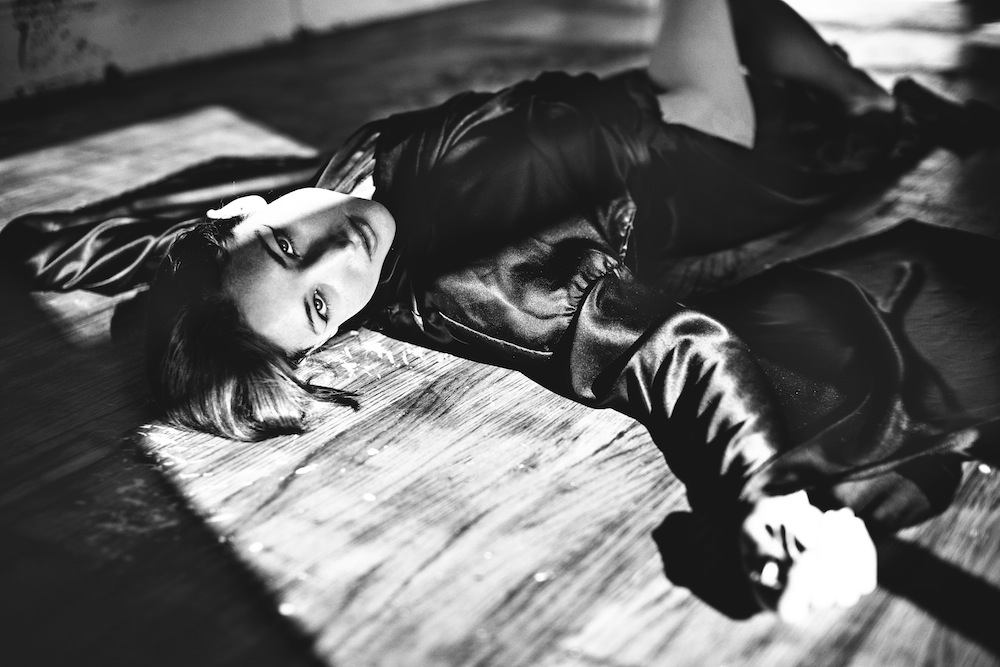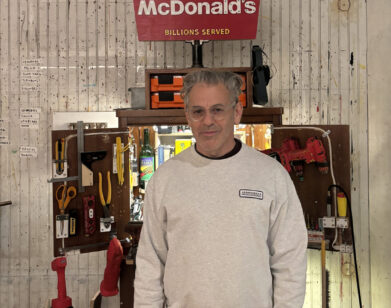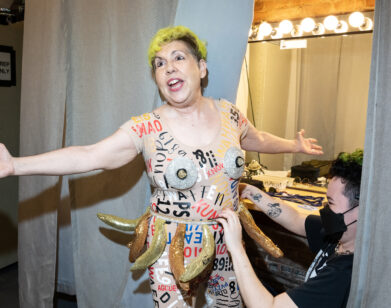Andrea Mary Marshall’s Fan Base
PORTRAIT OF ANDREA MARY MARSHALL, ABOVE, BY CHRISTOPHER GABELLO. OTHER PHOTOS COURTESY OF ANDREA MARY MARSHALL/GARIS & HAHN
Andrea Mary Marshall has been the New York art world’s reigning queen of personal reinvention over the last few years, constantly taking on dramatized new alter-egos for her self-portrait based work. This month, at “Sacred/Iconic” at Garis & Hahn gallery, she’s become the King: Elvis Presley, fused aesthetically and symbolically with a geisha, is at the center of the show. The construct is meant to express Marshall’s intertwined male and female identities.
And what a tangle it is. In four black-and-white photos, she poses in an unzipped black leather jacket and pants, a styling nod to Elvis’s 1968 Comeback Special, chest bared. Her black wig is in a geisha updo, sporting sideburns with the front slicked back. Her face is powdered white with a shadow of stubble; her eyebrows are darkened to look mannish. As both figures have fans, in separate senses, Marshall used literal fans to create four paint-splatter canvases. Each is signed with smears of red lipstick (applied with Marshall’s own lips)—”the beauty mark on the canvas,” as she describes it. Tattered, enamel-stained fan remnants are displayed nearby.
Two adjacent video projections in the gallery’s downstairs overlay the canvases. One video documents her in full Elvis-geisha regalia, executing the fan-made paintings by animatedly fluttering her wrists and dancing. She looked to films of Jackson Pollock working to develop her technique. In the second video, she plays the fan (as in, devoted follower), dressed in a short skirt and a black top, dizzily fanning herself (with a real fan) and swooning at Elvis—who, Marshall points out, is ignoring her.
Marshall started out in the fashion industry after graduating from Parsons in 2006, but sought a richer outlet for self-expression. She started taking self-portraits on the nights and weekends, delving into herself, then new sides of herself, and then new extremes of herself. For past shows, she’s fleshed out alter egos like the hyperbolic femme fatale Gia Condo and the violently reverent Rosemary Myst. This project, she says, is her most simple and authentic yet.
We met Marshall at Garis & Hahn on a Sunday afternoon, where she gave us a tour of the show. Notwithstanding a mischievous glint in her eye, she appeared pretty normal. It was almost hard to believe the same woman was on the walls of the gallery, posing, fanning, and flaunting away.
ANDREA MARY MARSHALL: I was looking at two cultural icons, Elvis and a geisha. I was looking at this gender-bender quality and the idea of symbolically opening the kimono. Of course, the geisha can’t marry. But my geisha is married to herself. I was always creating these alter egos. I do not think that this is an alter-ego or a character. I just think this is a figment of my imagination that symbolically represents a period of my life.
RACHEL SMALL: What period of your life?
MARSHALL: A coming to terms with myself. Dropping the alter-ego and letting all these extremes just be, not trying to figure it out. I was thinking of the fan and how Elvis has fans, and geishas have fans too. Geishas use them as the ultimate symbol of femininity, whereas Elvis uses his fans to elevate his masculinity. The fans have language, and use it as almost a tool through which to create these paintings, sort of like Jackson Pollock in a way. So I created these enamel, abstract self-portraits with the fan.
SMALL: In past projects, it seems like you were drawing on alter egos within you.
MARSHALL: I feel like I’m not pretending to be anybody. There are these two extremes of the masculine and feminine and rather than try to make sense of all of these contradictory things, I’m just letting them coexist. I think this project shows a certain amount of restraint that the projects in the past [didn’t].
SMALL: How did you stumble across this idea of the fan?
MARSHALL: I just got this idea when I was laying in bed one night, and I was like, “Fuck, I have to do this.” I just thought it was so beautiful, you know? I wanted to do something very beautiful, but also strip down all of the other projects and get down to something that was very raw. This is pretty much stripped down, restraint, lacking sort of the decadence and the opulence of the past. But I think it’s still saying something very strong about female artwork, with the way females paint.
SMALL: Part of Pollock was that the paint traced his psychological impulses. It’s interesting you have the fan mediating that now. It’s your impulses, but it’s this thing heavy with symbolism in between you and the painting.
MARSHALL: It’s revealing, but it’s also concealing in the same way. You use a fan to conceal yourself, but at the same time, its movements could identify gestures. The gestures identify what you’re feeling. Fans can tell a story–with the geishas and the fan dances, they tell a story. It has so much symbolism. Using it as a tool for painting, it’s the same thing in a way. It’s telling a story, because all of my work is autobiographical, but it’s also leaving a mystery.
SMALL: Is the geisha a fan of Elvis? Or is she married to him? Or is she his equal?
MARSHALL: I saw them both as very similar, in the way that the geisha has this sort of secret identity created through costume and wardrobe and craft, in the same way Elvis has. They’re both artists with their craft. It’s autobiographical, so it’s how I feel at this moment. That’s what I want to convey to my audience, is that it’s a journey.
SMALL: Why are these characters the best way of doing that?
MARSHALL: I don’t view them as characters. It’s easy to say that, but in the past, I viewed my work as alter-egos. The first thing was that I saw the image of the geisha fluttering the fan with the paint on it, creating the paintings. It evolved. I started watching Japanese cinema from the 1950s and I was like, “Wow, they’re so obsessed with American culture.” It was interesting to see a film in Japan in the 1950s where they’re dressed like American movie stars. And then I was like, “Wow, Elvis kind of looks like a geisha.” This is what I wanted to explore. I’ve always been confused by my own sexuality, but why do I have to figure it out? And then I started researching, and I saw there was a movement of Japanese rockabillies. There are people in Japan now who dress exactly like my portraits up there. So it was like, I have to do this. I want it to be elegant, you know? It was all done in the same night. All of the paintings were done during the video, in my home. It was literally, all the paintings were done that night. [looking at the fans] So then, this is the result from the film. They’re cool, right? They look like destroyed moth wings.
SMALL: I feel like now that the paint’s hardened on them, they’re almost tougher because they have this other layer.
MARSHALL: With the portraits, I wanted to make these iconic, if you will, images of the Elvis-geisha, of this man that I feel is part of me.
SMALL: Why did you pose as Elvis and not the geisha?
MARSHALL: Because I think it’s more about the geisha taking off the role of the kimono and becoming less this creature of controlled beauty, unleashing herself and allowing herself to explore other parts of her personality. Taking on the more dominant role, being less submissive. I thought that it was really more about that than anything else, removing that veil or that barrier and allowing yourself to try all these different things or be whoever you want to be, explore these different sides of yourself and being okay with that. You can be extremely masculine and still be extremely feminine and vice versa. I don’t think it has to be either or. I don’t know if I’m trying to be a guy or a woman here, and I don’t care. I think that right now, especially in this day and age, it doesn’t matter anymore. It’s becoming so gender-bending. It’s becoming so crossover. I think my work also has to reflect what’s happening at the time. When I started this project, I saw a young woman on the train who had just cut off her breasts. And she was hairy and she was probably going through the transition, but she still was wearing nail polish, and there was still a twinkle in her eye that seemed very feminine. It’s interesting, because gender doesn’t really matter anymore. I think that it’s becoming more, what’s the word?
SMALL: Fluid?
MARSHALLL: Exactly. Things are becoming more fluid.
SMALL: I would say that the paintings are very androgynous.
MARSHALL: They’re very androgynous, but that is a compliment. I wanted it to be very now, very modern. I struggle with the idea of sitting there and doing layers and layers of detailed painting. What’s pulsating to me is more of a performance idea, more of embodying different things and documenting the time, the women of the time, how the women are changing, and documenting the change in costume history, the change in the way women move, who they interact with.
SMALL: I know you started doing these self-portraits. When did performance become part of it?
MARSHALL: I think the photographs are performance. I get really into it. I feel like my life ends up mimicking the art, instead of the other way around. One of my friends, who’s an artist, said to me, “You kind of have these art ideas, and then you actually end up creating your life around the art,” around the concept. With Gia Condo, my life mimicked that crazy character. At that time I became this diabolical demon, fucking eyebrow-less freak of nature. I was living it out in a way that was so beyond myself. After that project, I felt I needed to bathe in holy water. I felt awful. With this project, I felt like it was the other way around. I felt like this was a poignant expression of my life. It was the other way. It was completely different.
SMALL: When you are performing in the gallery, are you in the same mental zone as when you are taking the photos?
MARSHAL: I don’t like performing live. I think I perform better behind camera, because there’s something so haunting about being by yourself. There’s no one around you. It’s like 4 o’clock in the morning, you’re like, “I’ve got to finish this. I haven’t eaten. I need to sleep.” I was taking little geisha naps. I was rolling up a towel. It’s not a joke. That’s how the geishas sleep. I was like, “What am I going to do? I need to lie down for half an hour.” I had that geisha wig on for 48 hours. I couldn’t take it off. If I had taken it off, I wouldn’t be able to get it back on. So I rolled up a little towel, I laid my head on it.
SMALL: You said before it was about opening the kimono. Why didn’t you show the kimono anywhere?
MARSHALL: Because it’s not modern. It’s about the idea of this geisha-like woman who’s always concealed, then coming out of that and exploring her identity. Maybe she’s a lesbian. Maybe she goes home and night and she wants to sleep with other geishas. Maybe she wants to get married and have children. Maybe she wants to be a priest. Maybe she wants to be a fireman. I just wanted her to get out, explore it.
SMALL: I feel when I first was looking at your work, the first thing I thought of was Cindy Sherman.
MARSHALL: I think Cindy Sherman is wonderful, but my work is not inspired by hers. I think my self-portraiture is more inspired by Frida Kahlo. For me, my work is more symbolic of emotional experiences in my life. It’s all based on either heart-wrenching experiences or extreme moments of passion. Those moments create these alter-egos or these artworks. It’s very cathartic. I feel like it’s how I make sense of things. I have these wild emotions, wild extremes. Up and down, up and down, up and down. My work is extremely autobiographical. It’s amazing to be walking through a gallery and showing your work to somebody and having them point out things that you didn’t even think of when you were creating it. That’s the magic of it. I just want to connect to other people. It’s you and the viewer. That I think is the whole point, to have somebody look at your work and have it be like a handshake, to really engage with it, to have them see something that relates to their own life or to inspire them to think differently.
SMALL: Is that what you want people to take away? A different perspective?
MARSHALL: I would like it to inspire people to open up. It’s extremely inspiring to me when someone sees something that relates to his or her own life in my work. Sometimes I talk about the artwork and I confuse people even more. Everything has so many double meanings in life. Nothing is what it seems.
“SACRED/ICONIC” IS ON VIEW AT GARIS & HAHN GALLERY THROUGH OCTOBER 19.







